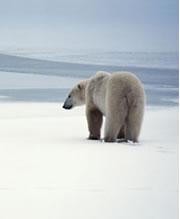 Barely there: some 22,000 - 25,000 polar bears are thought to be alive today.© Getty
Barely there: some 22,000 - 25,000 polar bears are thought to be alive today.© GettyThey are one of the emblems of international conservation, but polar bears are on thin ice. The 2006 edition of the global guidebook for species in danger, the IUCN Red List, published today, has officially upgraded the bears' status from 'conservation-dependent' to 'vulnerable'.
The change reflects a fundamental shift in polar bears' (Ursus maritimus) precarious circumstances. The bears are still embroiled in battle with their traditional foe, human hunters. But they're also coming under attack from a far more insidious pair of enemies: industrial pollution and global climate change. Similar challenges face 16,000 species now declared 'threatened' (see 'On the way out?').
Some climate models predict that summer sea ice in the Arctic could disappear by the end of this century. And if that happens, conservationists fear that the polar bears, which currently number between 22,000 and 25,000, could die out entirely.
Icy situation
“As sea ice retreats from year to year, the distance they have to swim increases - it weakens mothers, and thus weakens their cubs.”
Stefan Norris,
WWF, Oslo
Polar bears rely on fish and seals hunted out on the sea ice, explains Stefan Norris, head of conservation for the WWF's international Arctic programme, based in Oslo, Norway. The bears hibernate on land, however, and as climate change causes the ice front to recede, they will be forced to swim ever greater distances to bed down (see 'Drowning polar bears worry researchers').
"There is little doubt that polar bears will have a reduced range area and habitat quality in the future," the IUCN Red List report says. The most realistic expectation is that numbers will decline by around 30% over the coming 45 years, it concludes.
Added to that is the danger of industrial pollutants such as polychlorinated biphenyls (PCBs), flame retardants and heavy metals, all of which remain lodged in animals' fat reserves and accumulate in concentration as the chemicals travel up the food chain, Norris says. When polar bears use their fat reserves to weather the Arctic winter, these toxic compounds are released into their bloodstream.
Troubled history
Polar bears have been fighting for survival for decades. Virtually all indigenous Arctic peoples have a tradition of hunting the animals for fur and food, and the International Polar Bear Treaty, negotiated in the 1970s, allows around 700 bears to be killed each year by those who have traditionally done so in the past.
But this treaty was agreed at a time when the polar bears were battling for survival on the home front, says Norris. Now, the enemy is truly global.
Hunting quotas may eventually have to be revised, Norris says, although he adds that nobody is yet talking about abolishing them completely. Coming up with reasonable numbers will be difficult. Part of the problem is that the bears have hugely variable territory sizes: some have been known to range from Canada to Russia; others settle down in a small area. This makes modelling populations and setting hunting guidelines tricky.
Norris maintains that the best way to help polar bears is to address the new, global problem at its source. "It's fair to say that conservation management efforts will not be successful without tackling climate change," he says.
Fraught future
ADVERTISEMENT
The IUCN upgrade should raise awareness of the bears' plight, and Norris points out that 2007 is International Polar Year. Even still, "we are not drowning in research funds," he laments.
Most money for conservation research tends to come from petroleum companies and other big business looking to expand their interests into Arctic areas. Norris urges them to consider the impact on polar bears before they undertake such work, rather than after. "If it's a given that new infrastructure will be developed, then companies should identify the most vulnerable areas prior to development," he says.
Visit our bearssinkdeeperinto_d.html">newsblog to read and post comments about this story.
WWF, Oslo
